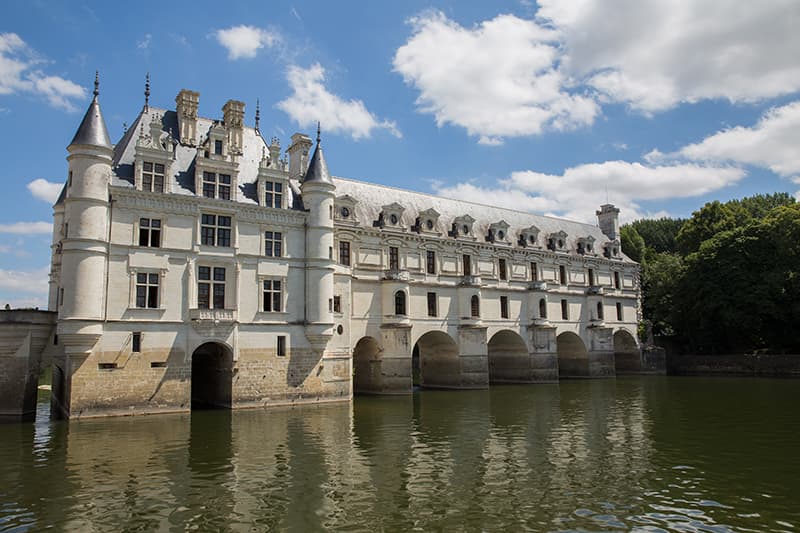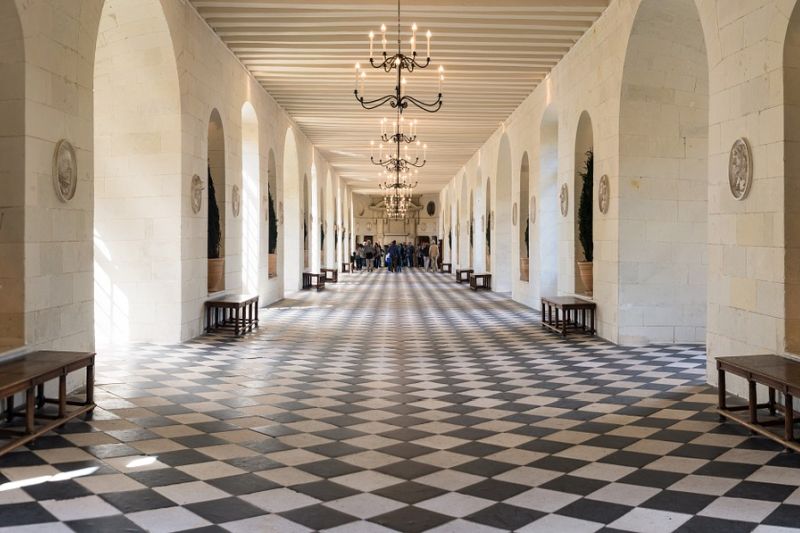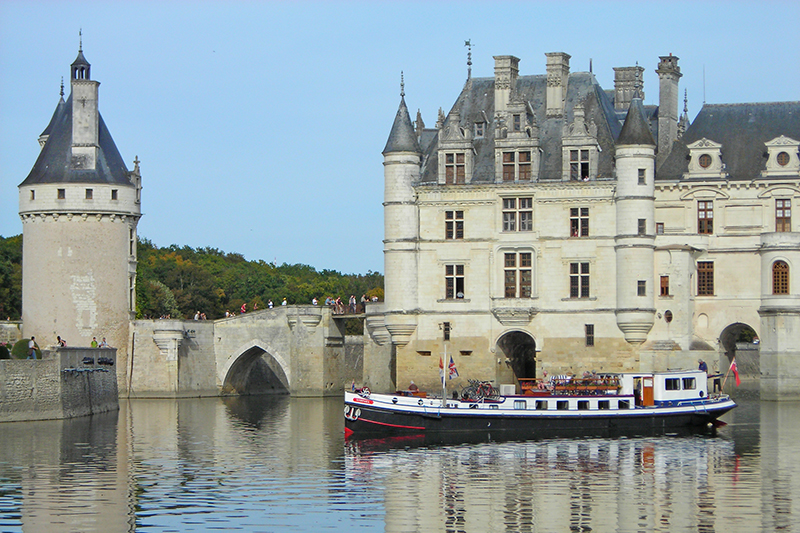Château de Chenonceau: The Château of Fairytales
The charming Château de Chenonceau in the Loire Valley is the castle of children’s fairytales. This stunning château boasts a five-arched bridge spanning the breadth of the River Cher, and shimmering grey slate roofs that provide contrast against the glowing white stonework. It’s not difficult to see why the spectacular Château de Chenonceau is the second most visited palace in all of France!
A marvel of French architecture, the château de Chenonceau was made magnificent by its many owners. Originally built under Thomas Bohier, its influential female residents gave the château de Chenonceau its nickname: ‘the ladies’ château’. During the sixteenth and eighteenth centuries, the château was owned by Diane de Poitiers, Catherine de Medici and Louise Dupin who all left their mark on its architecture and legacy.

Where is the Château de Chenonceau?
Built on the banks of the River Cher, the Château de Chenonceau is located near the small village of Chenonceaux in the Loire Valley. The Château de Chenonceau is well-known, as it is one of the most illustrious châteaux in the area. Collectively known as the châteaux of the Loire Valley, these castles are known for their links to French royalty and aristocracy, as well as their heritage and renaissance décor.
Who built the Château de Chenonceau?
Chenonceau was first referenced in the eleventh century, but all that stood in its place was an old mill next to the River Cher. The current château was designed by the French architect, Philbert de l’Orme between 1514 and 1522. The wing of the château that includes the gallery and bridge was created by Jean Bullant from 1570 to 1576.
The Château de Chenonceau is famous for its extravagant white stone façade and grey slate roofs. Its architecture incorporates both Gothic and Renaissance features. The château is also renowned for its spectacular landscape gardens, that were developed by some of its famous female owners. Chenonceau has been a designated historic monument since 1840 to protect it for future generations.

Who lived in the Château de Chenonceau?
Château de Chenonceau has had some notable residents – from the mistress of a king to a queen. These famous residents made some big changes to the architecture of the château and helped to shape its history.
1. Thomas Bohier
Thomas Bohier was the first owner of the Château de Chenonceau as it exists in its present state. He bought the estate in 1513 and demolished the residence in favour of rebuilding a brand new, state of the art château. As Chamberlain to King Charles VIII of France, he enjoyed popularity with the monarchy. His wife, Katherine, loved parties and hosted Francis I at the château on two occasions.
2. Diane de Poitiers
Château de Chenonceau was seized from Thomas Bohier’s son in 1535 after he failed to pay debts. On Francis I’s death, Henry II gifted the extravagant château to his mistress, Diane de Poitiers. Diane was an astute courtier with a keen intellect. She possessed significant influence over the king. Henry II even signed his official correspondence ‘HenriDiane’.
Diane de Poitiers adored Château de Chenonceau. She arranged for the bridge to be built over the River Cher, to connect her home to the opposite side of the river bank. She was also responsible for the creation of a set of spectacular gardens in front of the château that were prevented from flooding by stone terraces. Laid out in triangles, Diane had them planted with extensive flowerbeds, vegetable patches and orchards.
3. Catherine de Medici
Catherine de Medici was Henry II’s wife, and when the king died in 1559, she became regent on behalf of their ten-year-old son, Francis II. Catherine found herself with an increasing amount of political power when her husband died, and she used it to strike against Diane de Poitiers, who had caused her much jealousy and embarrassment during her marriage. Catherine forced Diane to exchange the Château de Chenonceau for another Loire valley residence, Château de Chaumont, and expelled Diane from court.
Catherine installed her son, Francis, at Château de Chenonceau and adopted an Italian style of luxury and splendour, in recognition of her heritage. She held the first ever firework display in France at the château on Francis II’s ascension to the French throne. As regent of France, Catherine de Medici ruled in her son’s stead from her study within the château, called the Green Cabinet.
It was during this period that the Château de Chenonceau gained its grand gallery over the bridge, which could be used for taking ‘exercise’ without residents needing to leave the safety of the château. Catherine de Medici also made changes to the gardens, modernising them and creating a new series of layouts.
4. Louise Dupin
Louise Dupin was married to a wealthy squire named Claude, who bought the Château de Chenonceau in 1733. The daughter of a financier and an actress, Louise was described by a historian of Chenonceau as an “intelligent, beautiful, and highly cultivated woman who had the theatre in her blood”.
Louise Dupin became known for holding meetings of intellectuals in her literary salon at Château de Chenonceau. Leaders of Enlightenment thought in France were attracted to the salon, including writers, philosophers and naturalists like Voltaire, Rousseau, Buffon, Condillac and many others.
It was Louise that saved Château de Chenonceau from destruction in the French Revolution of 1792, by claiming that its bridge was the only crossing over the River Cher for many miles.
5. The Menier Family
In 1913, Château de Chenonceau was bought by Henri Menier, a chocolatier. It is owned by the family to this day. The château was first opened to the public by the Meniers in 1913 and has hosted visits from head of states, like Harry Truman, and other personalities.
In the first world war, the gallery above the bridge was transformed into a hospital which helped to treat over 2250 injured patients. 120 beds were installed in the gallery under instruction from Gaston Menier, senator of Seine-et-Marne, who covered all expenses himself.
During the second world war, Château de Chenonceau was bombed by German forces and the chapel’s windows shattered. In addition, the château played a pivotal role in politics, aiding French citizens to move from Nazi-occupied France on one side of the riverbank, to the ‘free’ zone on the opposite side of the River Cher. The Menier family were instrumental in smuggling French citizens across the gallery to safety.
Following the war, Château de Chenonceau had been heavily damaged from bombing and a flood that destroyed the gardens. In the 1950s, the Menier family invested funds to restore the exquisite Loire Valley château to its former glory.
Things to see at the Château de Chenonceau
Aside from excellent views of the stunning architecture of Château de Chenonceau and its five-arched bridge, visitors to this Loire Valley château can see specific sights. The gardens of Château de Chenonceau include the Garden of Catherine of Medici and a maze. Guests can also see the chapel, wine cellar, and Francis I’s drawing room.
Cruise to Château de Chenonceau with European Waterways
If you’re convinced about visiting the Château de Chenonceau, then why not consider a hotel barge cruise? Book your cruise aboard 6-passenger hotel barge, Nymphea, and enjoy a once-in-a-lifetime opportunity to sail on the River Cher underneath the five-arched bridge of the Château de Chenonceau.

 English
English
 Spanish
Spanish French
French German
German Norwegian
Norwegian Portuguese
Portuguese Swedish
Swedish Italian
Italian Russian
Russian Simplified Chinese
Simplified Chinese Japanese
Japanese